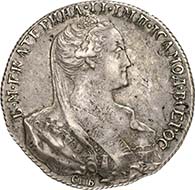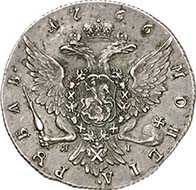December 22, 2011 – An entirely new numismatic discovery is set to cause a stir at the 2012 New York International Numismatic Convention. Lot 2092, a 1766 pattern Rouble depicting the bust of Catherine II, has for the first time been linked to a monumental official painting of the Tsarina by renowned artist Fedor Rokotov (pictured below with the 1766 Rouble). The lot is one of the greatest rarities in the Russian series and it is estimated that this piece will sell for around US $1,000,000.
Monumental official painting of the Tsarina Catherine II by Fedor Rokotov, 1763. On the right the 1766 Rouble Lot 2092.
Rokotov was an eminent portrait painter in Russia during the reign of Catherine II and painted her a number of times throughout her time on the throne. Having studied art at the St. Petersburg Academy of Arts he became known at the court after painting a portrait of Empress Elizaveta Petrovna. His 1763 portrait of Empress Catherine in her coronation dress is considered one of the best works of his early period. At the time, it made quite a stir and established Rokotov as, perhaps, the first Russian artist to master the methods and techniques of Western European formal painting. There is no doubt that this majestic work served as the principal basis for the engraver of the pattern Rouble. This is the only firmly established case in Russian numismatics where a direct connection could be traced between a monumental official painting and a monetary portrait.
The reign of Catherine II is known as the ‘Russian Enlightenment’. Catherine was a revered patron of the arts and was well known for a sense of style and taste that rivalled any of the other European courts. With her encouragement the Russian coinage production saw a flurry of activity and creativity during her reign. Master German engravers came to work side by side with Timofey Ivanov and his contemporary Samoil Yudin at the St. Petersburg mint. Ivanov would produce four successive and distinct portraits of Catherine on the Rouble, the bread and butter production of the St. Petersburg mint. Among these four bust types – 1762, 1766, 1777 and 1783 – one can see a number of subtle refinements and adjustments. Improvements and changes were ongoing to satisfy mint specifications, political needs and, of course, the approval of the Empress.
Lot 2092: 1766 Rouble of Catherine II. Estimated to sell for ca. $ 1,000,000.
In 1766 it was decided that a new medallic portrait of the Empress was required and lot 2092 is the pattern created by an unknown die engraver. Clearly officially commissioned (as indicated by the pattern’s mintmark and the master’s initials) the engraver would have been given one or more official portraits of Catherine to use as a model. However, the bust most resembles the 1763 painting of Catherine by Fyodor Rokotov.
The coin collection of the Grand Duke Georgii Mikhailovich, one of the finest Russian collections ever assembled, lacked an example. The Grand Duke himself knew of only two specimens, one in the Hermitage and the other in a private collection. In the Renaissance Sale of August 2000 an example was sold by public auction. The specimen offered here, a better example than the other two, brings the count up to three known pieces. It is unclear however whether the piece offered in the Renaissance Sale or the piece offered here is the ‘private collection specimen’ referred to by Grand Duke Mikhailovich.
This coin will be sold as part of The New York Sale XXVII-XXIX, alongside the spectacular Prospero Collection of ancient Greek coins, at the Waldorf Astoria Hotel in January 2012.
For more information visit the website of Baldwin’s.
For more information on The Prospero Collection please click here …
… and here.







